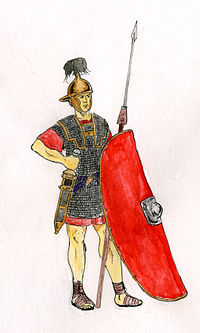
Gnaeus Pompeius Magnus, known in English as Pompey or Pompey the Great, was a general and statesman of the Roman Republic. He played a significant role in the transformation of Rome from republic to empire. Early in his career, he was a partisan and protégé of the Roman general and dictator Sulla; later, he became the political ally, and finally the enemy, of Julius Caesar.
80s BC is the time period from 89 BC – 80 BC.
Lucius Afranius was an ancient Roman plebeian and a client of Pompey the Great. He served Pompey as a legate during his Iberian campaigns, his eastern campaigns and remained in his service right through to the Civil War. He died in Africa right after the Battle of Thapsus in 46 BC.

Quintus Caecilius Metellus Pius was a general and statesman of the Roman Republic. Like the other members of the influential Caecilii Metelli family, he was a leader of the conservative faction, the Optimates, who opposed the popular faction, the Populares, during the last century of the Roman Republic.
Gaius Norbanus, nicknamed Balbus was a Roman politician who was elected consul in 83 BC alongside Lucius Cornelius Scipio Asiaticus. He committed suicide in exile at Rhodes after being proscribed by Lucius Cornelius Sulla shortly after the latter's victory in the civil war.

This is a historical timeline of Portugal.

The Battle of Mount Tifata was fought in 83 BC as part of Sulla's Second Civil War.
Marcus Terentius Varro Lucullus, younger brother of the more famous Lucius Licinius Lucullus, was a supporter of Lucius Cornelius Sulla and consul of ancient Rome in 73 BC. As proconsul of Macedonia in 72 BC, he defeated the Bessi in Thrace and advanced to the Danube and the west coast of the Black Sea. In addition, he was marginally involved in the Third Servile War.
Gaius Norbanus Flaccus was a Roman politician and general during the 1st century BC.
The gens Terentia was a plebeian family at ancient Rome. Dionysius mentions a Gaius Terentius Arsa, tribune of the plebs in 462 BC, but Livy calls him Terentilius, and from inscriptions this would seem to be a separate gens. No other Terentii appear in history until the time of the Second Punic War. Gaius Terentius Varro, one of the Roman commanders at the Battle of Cannae in 216 BC, was the first to hold the consulship. Members of this family are found as late as the third century AD.
Sulla's civil war was fought between the Roman general Lucius Cornelius Sulla and his opponents, the Cinna-Marius faction, in the years 83–82 BC. The war ended with a decisive battle just outside Rome itself. After the war the victorious Sulla made himself dictator of the Roman Republic.
The First Battle of Clusium was a battle that took place in June of 82 BC during the Roman Republic's Second Civil War. The battle pitted the Optimates under the command of Lucius Cornelius Sulla against the Populares commanded by Gnaeus Papirius Carbo. The battle was indecisive.

The Battle of Faventia was a battle that took place in September of 82 BC at Faventia during the context of Sulla's Second Civil War. The battle pitted the Optimates under the command of Quintus Caecilius Metellus Pius against the Populares forces commanded by Gaius Norbanus Balbus. The battle resulted in an Optimate victory.
The Battle of Lauron was fought in 76 BC by a rebel force under the command of the renegade Roman general Quintus Sertorius and an army of Roman Republic under the command of the Roman general Gnaeus Pompeius Magnus. The battle was part of the Sertorian War and ended in victory for Sertorius and his rebels. The battle was recorded in detail by Frontinus in his Stratagems and by Plutarch in his Lives of Sertorius and Pompey.
The Battle of Sucro was fought in 75 BC between a rebel army under the command of the Roman rebel Quintus Sertorius and a Roman army under the command of the Roman general Pompey. The battle was fought on the banks of the river Sucro near a town bearing the same name. It ended indecisively: with Sertorius winning a tactical victory but having to withdraw because Pompey's colleague Metellus and his army were approaching.
The Battle of Saguntum was fought in 75 BC between forces of the Roman Republic under the command of Gnaeus Pompeius Magnus and Quintus Caecilius Metellus Pius and an army of Sertorian rebels under the command of Quintus Sertorius. The location of the battle is disputed, but it was most likely near modern Langa de Duero, as Sallust informs us the battle was fought on the banks of the river Douro. The battle lasted from noon till night and ended in a draw.
The Battle of Italica was fought in 75 BC between a rebel army under the command of Lucius Hirtuleius a legate of the Roman rebel Quintus Sertorius and a Roman Republican army under the command of the Roman general and proconsul of Hispania Ulterior Quintus Caecilius Metellus Pius. The battle was fought near Italica and ended in a stunning victory for the Metellan army.
The Battle of Valentia was fought in 75 BC between a rebel army under the command of Marcus Perpenna Vento and a general called Gaius Herennius, both legates of the Roman rebel Quintus Sertorius, and a Roman Republican army under the command of the Roman general Gnaeus Pompeius Magnus. The battle was fought at Valentia in Spain and ended in a stunning victory for the Pompeian army.





